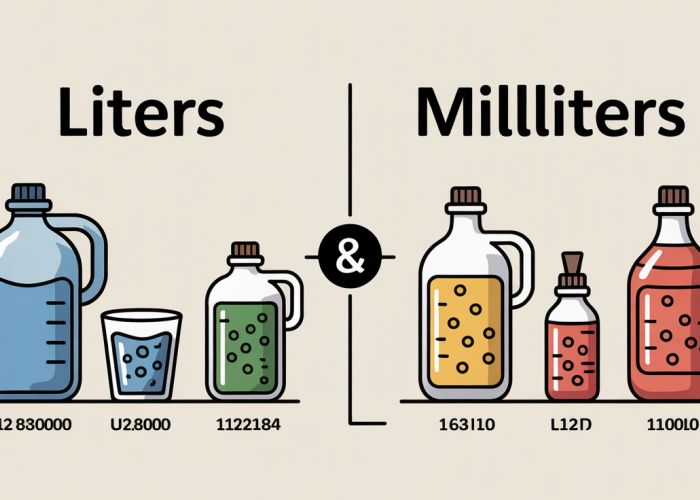Understanding volume is crucial, and the relationship between liters and milliliters is fundamental. Consider a measuring cup, a common household tool. Its capacity is frequently marked in both units. Fluid dynamics, a branch of physics, uses these conversions constantly when analyzing flow rates and volumes. This makes accurate conversion between l to milliliters essential. The metric system, designed for simplicity, defines 1 liter as 1000 milliliters; knowing this makes l to milliliters conversions straightforward.

Liters to Milliliters: Master Conversions Now! [Easy]
This article breaks down the conversion between liters (L) and milliliters (mL) in a straightforward and easy-to-understand way. We’ll cover the basics, provide practical examples, and offer quick conversion methods to help you master "l to milliliters" conversions.
Understanding Liters and Milliliters
Before diving into the conversion itself, let’s make sure we understand what liters and milliliters are and what they measure.
What is a Liter (L)?
- A liter is a unit of volume in the metric system.
- Think of it as a standard size container, often used for liquids like water, juice, or milk.
- A liter is a relatively large unit compared to a milliliter.
What is a Milliliter (mL)?
- A milliliter is also a unit of volume in the metric system.
- It’s a smaller unit compared to a liter.
- Milliliters are often used to measure smaller quantities, like medicine dosages or ingredients in a recipe.
The Relationship: l to Milliliters
The key is understanding the relationship between the two:
- 1 liter (L) is equal to 1000 milliliters (mL)
- This relationship is the foundation for all our conversions.
Converting Liters to Milliliters: The Simple Formula
The conversion from liters to milliliters is incredibly simple. You just need to remember one rule:
The Conversion Rule: Multiply by 1000
To convert liters to milliliters, multiply the number of liters by 1000.
- mL = L x 1000
Examples of l to Milliliters Conversions
Let’s put the formula into practice:
- Convert 2 liters to milliliters:
- mL = 2 L x 1000
- mL = 2000 mL
- Convert 0.5 liters to milliliters:
- mL = 0.5 L x 1000
- mL = 500 mL
- Convert 1.75 liters to milliliters:
- mL = 1.75 L x 1000
- mL = 1750 mL
As you can see, the process is consistently multiplying the liter value by 1000.
Quick Conversion Table: l to Milliliters
For quick reference, here’s a table with some common liter to milliliter conversions:
| Liters (L) | Milliliters (mL) |
|---|---|
| 1 | 1000 |
| 2 | 2000 |
| 5 | 5000 |
| 0.25 | 250 |
| 0.75 | 750 |
| 1.5 | 1500 |
Practical Applications of l to Milliliters Conversions
Understanding "l to milliliters" conversions is helpful in many everyday situations:
- Cooking and Baking: Recipes often use both liters and milliliters.
- Medicine Dosage: Measuring the correct amount of liquid medication is crucial.
- Hydration: Tracking your water intake, which is often measured in liters throughout the day, sometimes requires converting it into smaller mL amounts for specific tracking apps or tools.
- Science Experiments: Many scientific procedures require precise liquid measurements.
Frequently Asked Questions: Liters to Milliliters
Here are some common questions about converting liters to milliliters to help clarify the process.
Why is it important to know how to convert liters to milliliters?
Understanding how to convert l to milliliters is essential in many daily situations. This includes cooking, baking, medicine dosage, and scientific experiments where precise measurements are needed. Being able to quickly and accurately convert between l to milliliters prevents errors and ensures accurate results.
What is the exact conversion factor between liters and milliliters?
The conversion factor is quite simple: 1 liter (L) is equal to 1000 milliliters (mL). Therefore, to convert l to milliliters, you always multiply the number of liters by 1000. This relationship is foundational for accurate conversions.
How do I convert a decimal amount of liters to milliliters?
Converting a decimal amount of l to milliliters is done exactly the same way as a whole number: multiply the decimal number by 1000. For example, 0.5 liters equals 0.5 x 1000 = 500 milliliters.
Is there a simple way to mentally convert l to milliliters without a calculator?
Yes! Just visualize moving the decimal point three places to the right. For instance, 2.75 liters becomes 2750 milliliters. This trick works because you’re effectively multiplying by 1000 when converting l to milliliters.
Alright, you’ve got the basics of l to milliliters down! Go try it out in the kitchen or on your next project. Pretty simple, right?